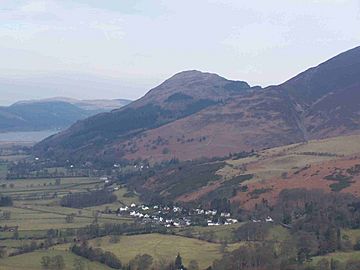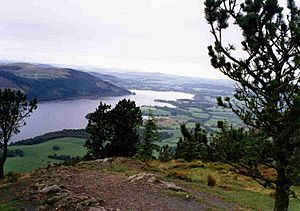Dodd (Lake District) facts for kids
Quick facts for kids Dodd |
|
|---|---|

Dodd seen from the south east; the village of Applethwaite sits in the valley
|
|
| Highest point | |
| Elevation | 502 m (1,647 ft) |
| Prominence | c. 120 m |
| Parent peak | Skiddaw |
| Listing | Wainwright |
| Geography | |
| Location | Cumbria, England |
| Parent range | Lake District, Northern Fells |
| OS grid | NY244273 |
| Topo map | OS Landrangers 89, 90, Explorer OL4 |
Dodd is a small fell (which means a hill or mountain) in the beautiful Lake District area of Cumbria, England. It's located about four kilometres north-west of Keswick. Dodd is part of the Skiddaw mountain range in the northern part of the national park. Its slopes are covered with many trees, forming a lovely forest.
Contents
Dodd Wood: A Changing Forest
Dodd is part of a forest area called Dodd Wood, which is managed by the Forestry Commission. For many years, tall conifer trees covered the top of Dodd. This meant that visitors couldn't see the amazing views from the summit.
However, things began to change in 2001. The Forestry Commission started to clear the trees from the very top of the fell. Now, the summit is open and clear. The hope is that the area will soon return to its natural state, becoming a heather moorland.
A famous guidebook writer named Alfred Wainwright really disliked how Dodd was covered in trees. He wrote about his strong feelings in his "Pictorial Guides to the Lakeland Fells" back in 1962. It took 40 years, but his wish to see the summit clear finally came true!
How Tall is Dodd?
Dodd stands at a height of 502 metres (about 1,647 feet) above sea level. You might see some maps, like the Ordnance Survey's Landranger series, that show a height of 491 metres.
This slightly lower height actually refers to a spot about 100 metres south of the true summit. If you look closely at a detailed map, you can see a 500 metre contour line right at the very top, confirming its true height.
Amazing Wildlife at Dodd
In recent years, Dodd and Dodd Wood have become a very popular spot for visitors. This is because the area near the southern end of Bassenthwaite Lake is home to something very special: Ospreys! These large birds of prey are quite rare in northern England. There are only four pairs that nest here, with the others being at Kielder Forest in Northumberland.
To help people see these amazing birds without disturbing them, an outdoor viewing platform was built on the slopes of Dodd in June 2001. From here, you can get a clear view of the osprey nest from a safe distance.
Dodd Wood is also one of the last places in Great Britain where you can find Red Squirrels. These cute native squirrels are facing challenges from the larger Grey Squirrel. The Forestry Commission and the Department for Environment, Food and Rural Affairs are working hard to protect the Red Squirrels in this area.
Climbing Dodd
Most people start their climb up Dodd from the car park near the Old Sawmill tea room. This is located on the A591 road, right across from a place called Mirehouse. There's a clear path that leads all the way to the summit.
If you're feeling adventurous, you can continue your walk from Dodd to the nearby fell of Carl Side. From there, you can even keep going to the top of Skiddaw. Skiddaw is one of England's few mountains that are over 3,000 feet tall!
The Summit View
The very top of Dodd has a stone memorial pillar. It has a brass plaque that says, "In memory of John Lole and Ian Sandelands, Ist Seaton Scout Group".
Even though Dodd isn't a very tall fell, the view from the top is absolutely fantastic! You can see the entire Bassenthwaite Lake and Derwent Water. On a clear day, you can also spot the high mountains of Scafell Pike, Great Gable, and Bowfell, which are about 21 kilometres away to the south. You can even see the hills of Dumfries and Galloway in Scotland to the north-west. See a computer-generated view from the summit
The Skiddaw Hermit
Back in the 1860s, Dodd was home to a unique person known as the Skiddaw Hermit. His name was George Smith, and he was from Scotland. He chose to live on a ledge on the fell in a wigwam-style tent. This tent was made from branches and built against a low stone wall.
George loved being outdoors and stayed there no matter the weather. He earned money by painting pictures of people and telling them about their personalities at local fairs. A short book about his interesting life, called "The Skiddaw Hermit," was written by Mary E. Burkett in 1996.
Images for kids




